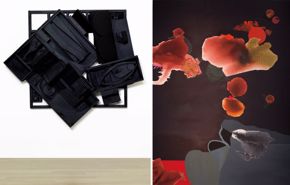The “Confident Exuberance” of Louise Nevelson & Dorothy Hood November 2, 2018

(left to right) Louis Nevelson, Mirror Shadow XII, 1985, painted wood, the Museum of Fine Arts, Houston, gift of Barry Weissler. © Estate of Louise Nevelson / Artists Rights Society (ARS), New York | Dorothy Hood, Untitled, late 1980s, oil on canvas, collection of the Art Museum of South Texas, Corpus Christi © Estate of Dorothy Hood
Louise Nevelson, no date, photograph courtesy of Pace Gallery. © Estate of Louise Nevelson / Artists Rights Society (ARS), New York
Dorothy Hood in front of “Subterranean Illuminations,” c. 1976, photograph courtesy of Meredith Long & Co. © Estate of Dorothy Hood
Louise Nevelson, Untitled, 1969, cardboard, wood, and paper on board, collection of Charles Dishman. © Estate of Louise Nevelson / Artists Rights Society (ARS), New York
Dorothy Hood, Haiti, 1969, oil on canvas, the Museum of Fine Arts, Houston, gift of Mr. and Mrs. Meredith J. Long. © Estate of Dorothy Hood
Louise Nevelson, Mirror Image I, 1969, painted wood, the Museum of Fine Arts, Houston, Museum purchase funded by The Brown Foundation, Inc. © Estate of Louise Nevelson / Artists Rights Society (ARS), New York
Dorothy Hood, Untitled, 1987, oil on canvas, collection of the Art Museum of South Texas, Corpus Christi. © Estate of Dorothy Hood
This fall, Kindred Spirits: Louise Nevelson & Dorothy Hood sparks a dialogue between two American artists whose work shares ambition, scale, and sources of inspiration.
I chatted with Alison de Lima Greene, the Isabel Brown Wilson Curator of Modern and Contemporary Art and the curator of Kindred Spirits, about Nevelson (1899–1988), Hood (1918–2000), and the exhibition that takes a fresh look at the common ground between these pioneering artists.
Why does the exhibition title refer to the two artists as “Kindred Spirits”?
To the best of our knowledge, Louise Nevelson and Dorothy Hood never met, although their lives intersected in interesting ways. They had friends and acquaintances in common, including Frida Kahlo and Diego Rivera. Their careers also followed parallel paths: Both took inspiration from Mexico and Pre-Columbian cultures, as well as from Cubism and Surrealism—influences that they synthesized into powerful abstractions to express the new spirit of midcentury American Modernism.
Did they have Houston connections?
Dorothy Hood was raised in Houston, and after many years of working outside this city in Mexico and New York, she returned in 1961. She taught at the MFAH Museum School from 1962 to 1979, and she became one of this city’s most celebrated painters.
Nevelson, based in New York for most of her adult life, visited Houston in 1969, when the MFAH organized a major retrospective of her sculptures. She is also well known for her Frozen Laces I, a 1980 steel sculpture on Smith Street in downtown Houston, near Allen Center.
Which works of art in Kindred Spirits speak to one another?
There are several telling juxtapositions in the show: Nevelson’s magnificent Mirror Image I (1969), which she created for her Houston retrospective, sets the stage for Hood’s first monumental canvas, Haiti (also 1969). The exhibition also features a strong selection of collages by both artists, as well as late works that demonstrate the confident exuberance Nevelson and Hood achieved in their final years. It is particularly exciting to see Hood’s final canvases of the 1980s side-by-side with Nevelson’s Mirror Shadow XII—compositions that explode with barely contained energy.
What do you hope visitors take away from the exhibition?
This is a tightly focused study of two artists who worked hard to establish independent careers. The juxtapositions between the works invite close looking, and perhaps a reappraisal of preconceived ideas. I hope young visitors will be inspired, and that more experienced visitors will see Nevelson and Hood in a new light, recognizing the vital contributions that Nevelson and Hood made to art in America.
See more in “Kindred Spirits: Louise Nevelson & Dorothy Hood,” on view in the Beck Building from November 3 through February 3.





